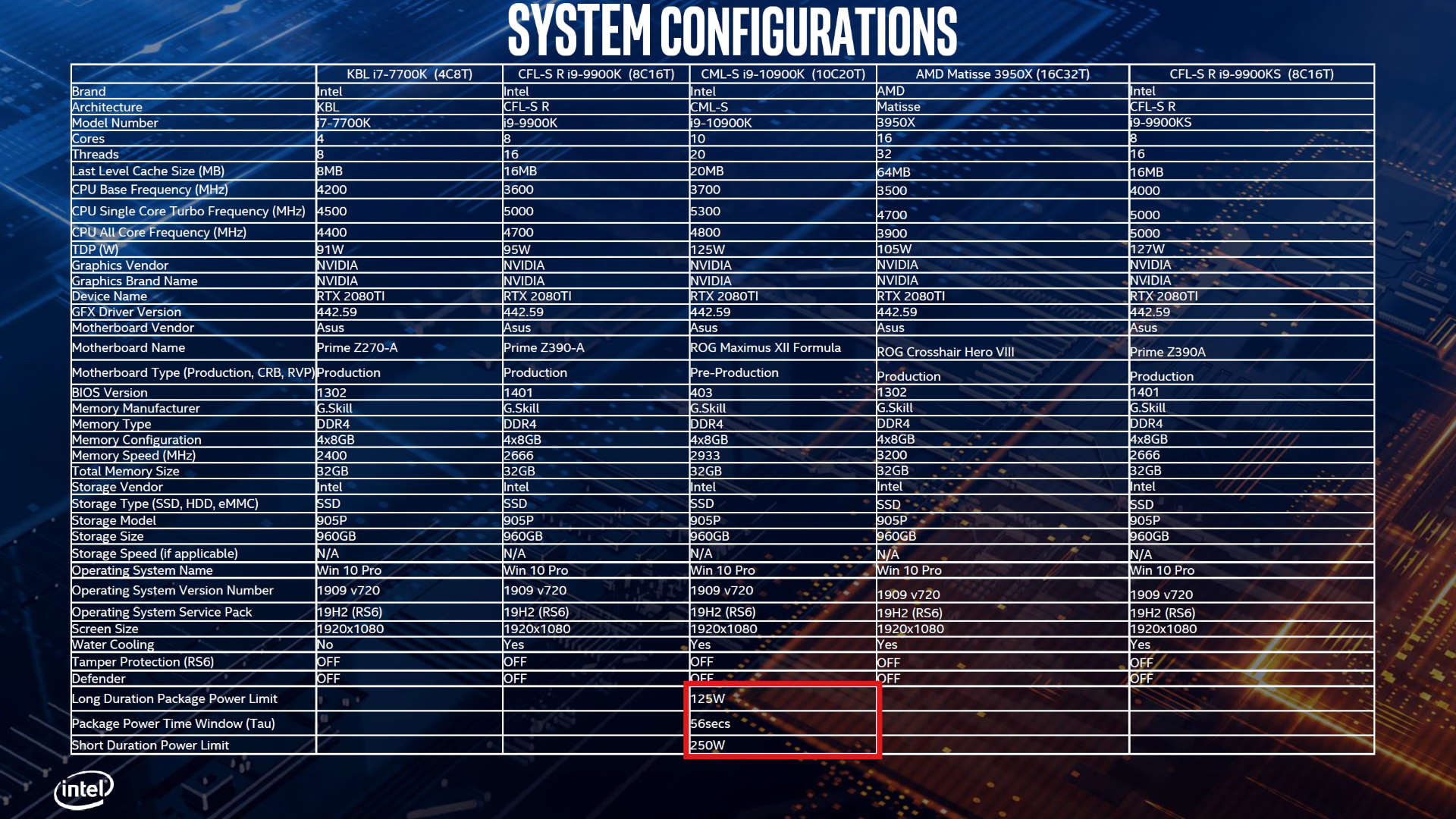Intel had to go power-crazy to create the 'world's fastest gaming processor'
The i9 10900K beats both the AMD Ryzen 9 3950X and the i9 9900KS... by drawing ungodly amounts of power.

'The world's fastest gaming processor.' That's how the Core i9 10900K, from the new Intel Comet Lake processor generation, is being marketed by the blue team. That's based on its own benchmarks, putting the 10-core chip's frame rate performance, across 25+ different games, up against that of the eight-core i9 9900KS and AMD's 16-core Ryzen 9 3950X.
By its own testing that's probably true, and we've seen Intel's traditional gaming performance keeping the big boy Ryzen mega-core chip down even against a Core i9 CPU with half the cores. Realistically then the competition for the 'world's fastest gaming processor' probably isn't coming from AMD, the competition is more about how it can keep the i9 10900K delivering higher gaming performance than the limited edition, now off-sale, Core i9 9900KS.
Running at a flat out 5GHz all-core clock speed the 9900KS is the real benchmark for gaming frame rates when it comes to raw processor power. And with a new generation of CPUs Intel is always one for bold claims, so it would've been a problem if the top-of-the-line Comet Lake chip wasn't the outright best, especially against a chip that was no longer even on sale.
So, how does Intel manage to get its 4.8GHz all-core processor to out-perform its last-gen 5GHz CPU, especially when in all the latest Comet Lake marketing material the company is making a big deal about how frequency is far more important than core count?
It throws an ungodly amount of power at the chip so it doesn't decide to throttle back on the potential Turbo opportunities of the Comet Lake CPU.
In the system configurations slide at the back of the latest press deck Intel says it set the PL2, the short-term power limit, at 250W. That's twice the base TDP of the Comet Lake chip, almost twice the base TDP of the 9900KS, and nearly 100W higher than that Coffee Lake processor's suggested PL2 rating.

Intel also set the Tau, the set amount of time the chip will draw that much power, at 56 seconds just so it could beat the rest. Given that there's no information offered as to what the 9900KS was sat at we can assume it was running at the recommended 159W PL2 level and 28 second Tau.
The biggest gaming news, reviews and hardware deals
Keep up to date with the most important stories and the best deals, as picked by the PC Gamer team.
With all that taken into consideration you can see how Intel is touting the 10900K as 'the world's fastest gaming processor' even though you've got to put a bit of effort, and a whole lot of power, to get it running like that.
It's also worth mentioning that while 250W is being given as the PL2 recommendation for the 10900K, Anandtech's Ian Cutress says that motherboard vendors claim they're building Z490 boards for a lot more…
The power demands are one thing we're going to be interested to check on once we get our Comet Lake sample through the door, and into my makeshift test lab, but if I'm honest the 10900K isn't why we're excited about the new 10th Gen CPUs. With the introduction of HyperThreading throughout the range it's the mid- and entry-level processors that are more tempting to us PC gamers.
| Header Cell - Column 0 | Intel Core i5 10400F | AMD Ryzen 5 3600 | Intel Core i3 10100 | AMD Ryzen 3 3300X |
|---|---|---|---|---|
| Cores | Threads | 6 | 12 | 6 | 12 | 4 | 8 | 4 | 8 |
| Base clock | 2.9GHz | 3.6GHz | 3.6GHz | 3.8GHz |
| Boost clock | 4.3GHz | 4.2GHz | 4.3GHz | 4.3GHz |
| TDP | 65W | 65W | 65W | 65W |
| Price | $157 | $172 | $122 | $120 |
That's what's going to give Intel a chance to go head-to-head with AMD's popular Ryzen processors, especially when you look at the six-core, 12-thread Core i5 10400F coming in cheaper than the similarly specced, but slower clocked, Ryzen 5 3600. There's also the quad-core Core i3 10100 at the same price and spec as the new Ryzen 3 3300X.
All of those sub-$200 CPUs should be excellent gaming CPUs, which means we could be in for some serious budget gaming rigs in the next few months.

Dave has been gaming since the days of Zaxxon and Lady Bug on the Colecovision, and code books for the Commodore Vic 20 (Death Race 2000!). He built his first gaming PC at the tender age of 16, and finally finished bug-fixing the Cyrix-based system around a year later. When he dropped it out of the window. He first started writing for Official PlayStation Magazine and Xbox World many decades ago, then moved onto PC Format full-time, then PC Gamer, TechRadar, and T3 among others. Now he's back, writing about the nightmarish graphics card market, CPUs with more cores than sense, gaming laptops hotter than the sun, and SSDs more capacious than a Cybertruck.

